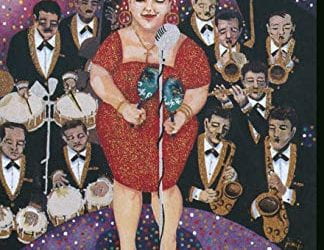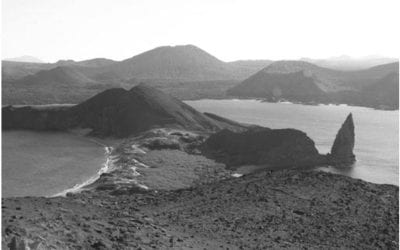A Survey of Costa Rican Birds
Inside and Out

“Mosquerito de Yelmo (Lophotriccus pileatus), Scale-crested Pygmy-tyrant” PHOTOGRAPHS BY JEREMIAH TRIMBLE © PRESIDENT AND FELLOWS OF HARVARD COLLEGE
“Put down your weapons and don’t move!”
From the dense vegetation of the Costa Rican forest, five men dressed in camouflage uniforms and armed with carbines burst into view and ran across the road.
“Don’t move! We’ll be back to pick you up,” the team leader shouted to us. As quickly as they emerged, they vanished into the underbrush bordering the Río Cuajiniquil, a small stream running northwest through Costa Rica’s Parque Nacional de Santa Rosa near the Nicaraguan border. Jeremiah Trimble, Curatorial Assistant in the Bird Department at Harvard’s Museum of Comparative Zoology, and I dropped our shotguns and well, we didn’t move. I was aghast. We had just begun working in Costa Rica, at the Área de Conservación, Guanacaste (ACG), a complex of three national parks and associated reserves and protected areas under the administration of the country’s Ministerio del Ambiente y Energía. Under arrest by the authorities was not how I intended to start this project. We had come to the ACG in June 2001, at the invitation of Señor Róger Blanco, ACG Director of Scientific Research, to participate in a project designed to survey the parasites of all of the vertebrate animals found within the conservation area’s boundaries. In addition to administering Costa Rican national parks, the ACG and the other ten Áreas de Conservación in Costa Rica serve as the centers for research, public education, and conservation of the country’s biodiversity. In a long-standing tradition here, documenting and cataloging the complexity of the natural world is equally important as research designed to understand the patterns and processes of biodiversity. So is work to conserve and protect the natural habitats. Daniel Brooks, University of Toronto, had begun an inventory of the parasitic organisms associated with vertebrate animals. However, he had not fully attempted the most difficult group—birds. They are by far more numerous than fish, reptiles, and mammals here, and they are difficult to capture. This is where I came into the picture. Dan and I have worked together for several decades—even co-authoring a book together. My current research emphasis on viral diseases in wild birds made it easy for me to accept the invitation to participate in the parasite inventory. Several avian viruses have become more prominent in public awareness than many others have in the past, in particular, West Nile Disease Virus and Influenza. These diseases are known as zoonotics, ones that originate in animals and “jump” to humans. (SARS is another zoonotic disease, for example, but it is thought to have originated in small Chinese carnivores, Palm Civets, rather than in birds.) What interests me particularly about avian zoonotic disease is understanding the evolution and ecology of virus-animal systems. I seek to discover how different types or viral strains have evolved with different host species of birds, and what role the environment—where the birds and virus live—has in generating new strains, and new combinations of viruses and susceptible hosts. In order to get the basic information about which strain and type of virus is found with which species of bird, and where and when, we catch birds and from them collect samples of body fluids that we later analyze in the laboratory. Some of our target viruses, such as Newcastle Disease Virus, are known already to occur in rainforest birds. This virus usually causes low-grade symptoms in infected birds, but under certain circumstances, the virus can mutate into a very virulent form and kill thousands of wild birds. When it jumps to domesticated birds, such as chickens and other poultry, the results can be economically devastating. We are screening for other viruses not currently known to occur in resident birds, such as West Nile Virus, but which are found in migratory species and thus inevitably are a threat to wildlife in Costa Rica and the rest of Latin America. Emerging infectious diseases will have the most serious consequences in small isolated populations, and species with no history of infection. Many of the charismatic birds of Central and South America like the Quetzal, toucans, and parrots, fall into this category and are potentially very susceptible to diseases of this kind.
We usually catch birds with mist nets that are finely woven of very thin, nearly invisible nylon threads—once we even captured two Austrian entomologists who walked into our nets while looking for ground beetles. The nets, however, work well for only the small proportion of forest birds that forage within about two meters of the ground. The residents of the middle and upper canopy of the rainforest and high-flying birds—more than half of the total—are completely missed. We had an additional problem as well. Most of the parasitic worms found in birds can only be recovered by dissection of a killed bird. That meant that we needed to collect birds with shotguns in addition to using nets. (All of the birds that were dissected by the parasitologists were made into scientific specimens that are now held in the Museum of Comparative Zoology at Harvard or in Costa Rica.)
“Have you seen anyone else? Who is firing at our wildlife? Who are you?”
The leader of the armed band of “guerrillas” had returned with his men, and it was clear from their muddy uniforms and rapidly developing welts that they had not found it easy going through the underbrush.
“We are scientists working on birds…” As I started to explain what we were doing, I noticed that he was wearing an ACG insignia and had information brochures about the park in his shirt pocket. These were the park guards, not the National Police.
Alas, the memos describing our activities were still buried on someone’s desk; the park guards had spent the morning patrolling the park borders looking for poachers and illegal fires. As a result, they’d missed the radio announcement of our activities; and I had neglected the basic courtesy of speaking with the people responsible for protection of the park before we started our work. Their relief in learning that we were neither drug or weapons smugglers, nor adventurous but misguided tourists, was tempered by their unnecessary early morning jog through the Tropical Dry Forest. They would go to any lengths to protect the integrity of the national park, but false alarms caused by inconsiderate gringo cientificos strained the limits of hospitality. After this, I notified the guards before we set out, and we avoided armed confrontations.
The success of Costa Rica’s national park system is strengthened by the dedication and passion of the people who work there: the guards that protect the plant and animal life, the educators who teach local people about the natural history and biodiversity of their environment, and the technicians who assist in research activities like ours. The latter group are called parataxonomists, who are people recruited from nearby rural areas and who have been highly trained in scientific collecting, basic taxonomy, and specific research techniques. Much of the fieldwork and specimen collection associated with Costa Rica’s national biodiversity inventory conducted by the Instituto Nacional de Biodiversidad (INBio) is done by parataxonomists. We were quite fortunate in having three very skilled parataxonomists working with us, Calixto Moraga, Petrona Rios, and Elda Araya. But our project presented some issues they had not experienced before, and one that I hadn’t anticipated.
“Which word do you want me to use? Guano or…?” Calixto asked me as he was entering data into the computerized database on parasites and hosts maintained by Dan Brooks
I agreed but had no answer. I also knew many synonyms of this word in Spanish, but most (all in my case) are not suitable for a scientific publication or this magazine. This was a problem of many dimensions. What goes into a bird from the front comes out of the bird in the rear, and it serves as convenient medium for detection of viruses, bacteria, eggs of parasitic worms, and the other subjects of our inventory. It also is a source of infectious disease carried by birds, and thus can be a concern for public health and domestic agriculture. Our inventory of avian parasites was useful at several levels, not only as an academic survey of biodiversity, but also as a tool for medical and veterinary science. Petrona and Elda supplied the term (“heces”) and observed that men are often useless in matters subtle and delicate.
With the help of the parataxonomists, volunteers, and students, we have documented more than 450 species of birds in northwestern Costa Rica, which is equivalent to the number of species breeding north of Mexico. From these, we have recovered thousands of species of parasites, most of which are unknown to science. As our knowledge of the diversity and complexity of life in tropical regions increases, and we know more about the members of the hidden world of parasitic organisms, we become better prepared in understanding the strength and fragility of our natural world. Empowering local people in gathering and interpreting this knowledge, as we are fortunately able to do at the ACG, facilitates this work and raises the environmental literacy of those most greatly affected by the state of the environment.
Fall 2004/Winter 2005, Volume III, Number 1
Douglas Causey is Senior Biologist of the Museum of Comparative Zoology and Affiliate of the Belfer Center for Science and International Affairs, Kennedy School of Government.
Related Articles
Editor’s Letter: Flora and Fauna
Ellen Schneider’s description of Sandinista leader Daniel Ortega in her provocative article on Nicaraguan democracy sent me scurrying to my oversized scrapbooks of newspaper articles. I wanted to show her that rather than being perceived as a caudillo
Bilingual Aesthetics: A New Sentimental Education
After an exhausting game of soccer with a crew of Mexico City street children, Vicente, a young teenager of 13 said, “Vamonos a la verga.” It was my third day with Casa Alianza, the international…
Nature and Citizenship
Two first-time visitors to the Galapagos archipelago begin their experience in exactly the same way. Two hours after departing mainland Ecuador, their plane descends towards the island of…




